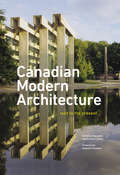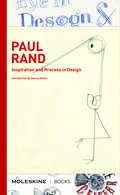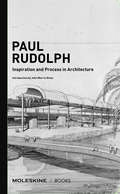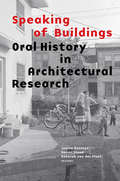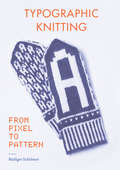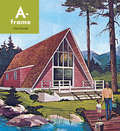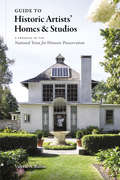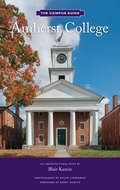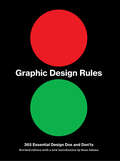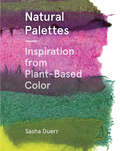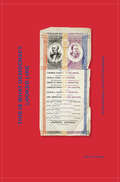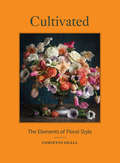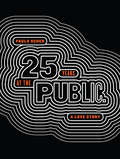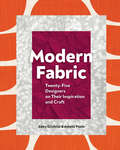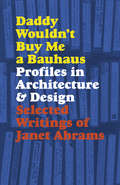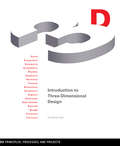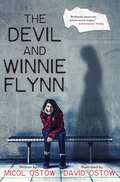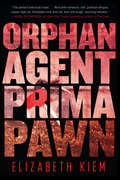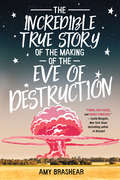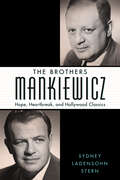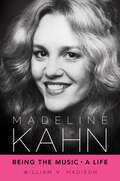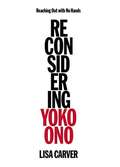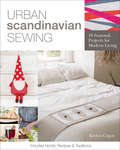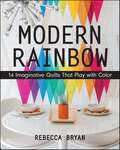- Table View
- List View
Canadian Modern Architecture: A Fifty Year Retrospective (1967-2017)
by Elsa Lam Graham LiveseyCanada's most distinguished architectural critics and scholars offer fresh insights into the country's unique modern and contemporary architecture. Beginning with the nation's centennial and Expo 67 in Montreal, this fifty-year retrospective covers the defining of national institutions and movements, how Canadian architects interpreted major external trends, regional and indigenous architectural tendencies, and the influence of architects in Canada's three largest cities — Toronto, Montreal, and Vancouver. Co-published with Canadian Architect, this comprehensive reference book is extensively illustrated and includes fifteen specially commissioned essays.
Paul Rand: Inspiration & Process in Design (Inspiration & Process)
by Steven Heller Eugenia BellBest-known for his corporate brand logos and art direction, Paul Rand (1914–1986) transformed commercial art from craft to profession, introduced European design standards to American commercial art, influenced the look of advertising and book design, and altered the ways in which major corporations including IBM, UPS, and Westinghouse did business. His adherence to a strict design form in his work for corporate clients was balanced by a playful side , captured in this spirited collection of literal (and figural) back-of-the-envelope sketches, doodles, notes, and imaginative sparks that later found their full form in his children's books, logos, and personal work.
Paul Rudolph: Inspiration & Process in Architecture (Inspiration & Process)
by John Morris Dixon Eugenia BellPaul Rudolph (1918–1997) authored some of Modernism's most powerful designs and served as an influential educator while chair of Yale's School of Architecture. His early residential work in Sarasota, Florida, garnered international attention, and his later exploration of Brutalist materials nd forms, most famously embodied in his Yale Art & Architecture Building (1963), earned Rudolph both notoriety and acclaim.Many of the dynamic drawings included in this collection — selected from the architect's archive housed in the Library of Congress — illustrate his highly emotive hand and deft drafting skill. They include his designs for Tuskegee University Chapel, Interama, Lower Manhattan Expressway, his analysis of Mies van der Rohe's Barcelona Pavilion, and his own inventive penthouse on Beekman Place in New York City. A lively Rudolph interview, conducted in 1986, and a newly commissioned introductory essay provide context for the drawings.
Speaking of Buildings: Oral History in Architectural Research
by Janina Gosseye Naomi Stead Deborah van der PlaatBy and large, architectural historians use texts, drawings, and photographs to craft their narratives. Oral testimony from those who actually occupy or construct buildings is rarely taken as seriously. Speaking of Buildings offers a rebuttal, theorizing the radical potential of a methodology that has historically been cast as unreliable. Essays by an international group of scholars look at varied topics, from the role of gossip in undermining masculine narratives in architecture to workers' accounts of building with cement in midcentury London to a sound art piece created by oral testimonies from Los Angeles public housing residents. In sum, the authors call for a renewed form of listening to enrich our understanding of what buildings are, what they do, and what they mean to people.
Typographic Knitting: From Pixel to Pattern
by Rudiger SchlomerLearn to knit a variety of typefaces modeled on digital designs by well-known type foundries including Emigre, Lineto, and Typotheque, and emblazon your hats, scarves, and sweaters with smartly designed monograms, letters, or words. Beginning with knitting basics, tips, and resources, and progressing through more advanced techniques, Typographic Knitting provides a systematic introduction on how to construct a variety of letter designs using different knitting techniques. This book bridges the gap between craft and design in a new way, and will delight typography connoisseurs, avid knitters, and makers looking for a novel medium.
A-Frame: Revised Edition
by Chad RandlThe heyday of the national A-frame craze saw tens of thousands of these easy and affordable structures built as vacation homes, roadside restaurants, churches, and even pet stores. A-frame chronicles America's love affair with the A-frame, from postwar getaway to its recent revival among designers and DIYers. In a fascinating look at this architectural phenomenon, Chad Randl tells the story of the triangle house, from prehistoric Japan to its lifestyle-changing prime in the 1960s as a symbol of play, leisure, and outdoor living. Part architectural history and part cultural exploration, the book documents every aspect of A-frame living with cartoons, ads, high-style and do-it-yourself examples, family snapshots, and an appendix with a complete set of blueprints in case you want to build your own.
A Guide to Historic Artists' Home and Studios
by Valerie BalintFrom the desert vistas of Georgia O'Keeffe's New Mexico ranch to Jackson Pollock and Lee Krasner's Hamptons cottage, step into the homes and studios of illustrious American artists and witness creativity in the making. Celebrating the twentieth anniversary of the Historic Artists' Homes and Studios program of the National Trust for Historic Preservation, this is the first guidebook to the forty-four site museums in the network, located across all regions of the United States and all open to the public. The guide conveys each artist's visual legacy and sets each site in the context of its architecture and landscape, which often were designed by the artists themselves.Through portraits, artwork, and site photos, discover the powerful influence of place on American greats such as Andrew Wyeth, Grant Wood, Winslow Homer, and Donald Judd as well as lesser-known but equally creative figures who made important contributions to cultural history—photographer Alice Austen and muralist Clementine Hunter among them.
Amherst College: The Campus Guide (The Campus Guide)
by Blair KaminAmherst College: The Campus Guide is an architectural tour of one of North America's most prestigious liberal arts colleges. Founded in Western Massachusetts some two hundred years ago, the one thousand-acre campus is a living museum of architectural history, bearing the imprint of distinguished firms in architecture and landscape architecture: Frederick Law Olmsted; McKim, Mead & White; Benjamin Thompson; Edward Larrabee Barnes; Shepley Bulfinch; and Michael Van Valkenburgh. Organized as a series of six walks, the guide interweaves the history of the college with the story of the campus's development. Newly commissioned photographs and a hand drawn pocket map enhance this engaging journey through Amherst's architecture, landscape, interior design, and sculpture.
Graphic Design Rules: 365 Essential Design Dos and Don'ts
by Tony Seddon Sean Adams Peter Dawson John FosterDON'T use comic sans (except ironically!) but DO worship the classic typefaces like Helvetica and Garamond. Graphic Design Rules is a handy guide for professional graphic designers, students, and laymen who incorporate graphic design into their job or small business. Packed with practical advice, this spirited collection of design dos and don'ts takes readers through 365 rules like knowing when to use a modular grid—and when to throw the grid out the window. All designers will appreciate tips and lessons from these highly accomplished authors, who draw on years of experience to help you create good design.
Natural Palettes: Inspirational Plant-Based Color Systems
by Sasha Duerr“The plant-lover’s alternative to the Pantone color guide.”—Julia Sherman, creator of Salad for President Renowned natural dyer, artist, and educator Sasha Duerr envisions a new age of fresh, modern color palettes, drawing from our original source of inspiration and ingredients—the natural world around us. This innovative plant-based color guide includes twenty-five palettes with five hundred natural color swatches, providing a bounty of ideas for sustainable fashion, textiles, fine art, floral design, food, medicine, gardening, interior design, and other creative disciplines. Bring the healing power of forest bathing into your home with a palette of spruce cones, pine needles, and balsam branches. Move past Pantone and embrace the natural balance of a pollinator palette with Hopi sunflower, red poppy, echinacea, and scabiosa.Duerr complements her palettes with illuminating reflections on connections between color and landscape, the healing properties of medicinal plants, the ways food and floral waste can be regenerated to enhance lifestyle experiences, the ecological benefits of using natural colors, and more. You may never view color—or the plants that surround us—the same way again.
This is What Democracy Looked Like: A Visual History of the Printed Ballot
by Alicia Yin ChengThis Is What Democracy Looked Like, the first illustrated history of printed ballot design, illuminates the noble but often flawed process at the heart of our democracy. An exploration and celebration of US ballots from the nineteenth and early twentieth centuries, this visual history reveals unregulated, outlandish, and, at times, absurd designs that reflect the explosive growth and changing face of the voting public. The ballots offer insight into a pivotal time in American history—a period of tectonic shifts in the electoral system—fraught with electoral fraud, disenfranchisement, scams, and skullduggery, as parties printed their own tickets and voters risked their lives going to the polls.
Cultivated: The Elements of Floral Style
by Christin GeallCultivated: The Elements of Floral Style elevates floral design to fine art in this richly informative work on the principles of floral style. A charming and intelligent mentor, Christin Geall emboldens designers, gardeners, and entrepreneurs to think differently and deeply about their work with flowers as she draws upon the fine arts and historical sources, exploring Baroque music, the paintings of the Impressionists, or the work of floral innovators like Gertrude Jekyll and Constance Spry.Covering all aspects of floral design, including choosing plants to grow and arrange, selecting tools and vessels, balancing color and form, and even photographing and selling arrangements, Cultivated offers universal lessons for all levels of practitioners, budgets, and materials. Geall's stunning photographs of her own lush designs illustrate techniques for creating brilliant arrangements that spark the imagination.
Paula Scher: Twenty-Five Years at the Public: A Love Story
by Paula ScherA larger-than-life figure in the design community with a client list to match, Paula Scher turned her first major project as a partner at Pentagram into a formative twenty-five-year relationship with the Public Theater in New York. This behind-the-scenes account of the relationship between Scher and "the Public," as it's affectionately known, chronicles over two decades of brand and identity development and an evolving creative process in a unique "autobiography of graphic design."
Modern Fabric: Twenty-Five Designers on Their Inspiration and Craft
by Abby Gilchrist Amelia PooleStep inside the studios of today's modern fabric design stars from around the world. From the bold florals of Kaffe Fassett to the subtle patterning of Naomi Ito to the retro style of design collective Ruby Star Society, Modern Fabric features a sophisticated, eclectic group of designers working in an exciting variety of techniques. <P><P>Engaging essays explore each designer's life in textiles: education, design beginnings, creative process, dreams, and how they run their businesses. Hundreds of color photographs offer endless inspiration, showing studio spaces, process, textile samples, and products made from the gorgeous fabrics featured in the book. Modern Fabric is an ideal resource for sewers, quilters, crafters, designers, and all those who aspire to a fun, color-filled, modern lifestyle.
Daddy Wouldn't Buy Me a Bauhaus: Profiles in Architecture and Design
by Janet AbramsDaddy Wouldn't Buy Me a Bauhaus collects the unparalleled writings of legendary British wordsmith Janet Abrams for the first time. From pivotal figures in international modernism to the pioneers of digital medium, Abrams explored the ideas, theories, and emotions that fueled their work.The book's twenty-six profiles, written in Abrams's signature, personal, often hilarious style, include Reyner Banham, Berthold Lubetkin, Philip Johnson, Paul Rand, Phyllis Lambert, Frank Gehry, Rem Koolhaas, Muriel Cooper, April Greiman, and Michael Bloomberg. Many of the profiles are back in print for the first time, having originally appeared in Blueprint, I.D. magazine, the Independent, and in books and catalogs from the 1980s through the early 2000s. A foreword by Blueprint's founding editor, Deyan Sudjic, and new reflections by Abrams set the stage.
Introduction to Three-Dimensional Design: Principles, Processes, and Projects (Design Brief Ser.)
by Kimberly ElamIntroduction to Three-Dimensional Design is the first book to teach graphic design students the fundamentals of three-dimensional design through hands-on drawing and model projects. The book combines key concepts with carefully crafted exercises so students can apply three-dimensional design principles in practice. From initial sketches through experimental prototypes to the final model solutions, students will develop a deeper understanding of the often complex elements and principles of three-dimensional design.
Inside Paragraphs: Typographic Fundamentals
by Cyrus HighsmithWhat goes on inside a paragraph of printed text? Cyrus Highsmith's Inside Paragraphs is an essential primer on the basics of typography that focuses specifically on the role of printed text within a paragraph. Engaging full-page illustrations and Highsmith's accessible explanations show the role of white space between letters, words, and lines. Perfect for students and professionals alike, this updated edition includes a new preface.
The Devil and Winnie Flynn
by Micol Ostow"A love letter to all your favorite horror movie classics . . . Micol Ostow's razor sharp writing and David Ostow's wonderful illustrations combine for an unforgettable reading experience."—Courtney Summers, author of This Is Not a Test and All the RageWinnie Flynn doesn&’t believe in ghosts. (Though she wouldn&’t mind a visit from her mom, explaining why she took her own life.) When her mysterious aunt Maggie, a high-profile TV producer, recruits Winnie to spend a summer working as a production assistant on her current reality hit, Fantastic, Fearsome, she suddenly finds herself in the one place her mother would never go: New Jersey.New Jersey&’s famous Devil makes perfect fodder for Maggie&’s show. But as the filming progresses, Winnie sees and hears things that make her think that the Devil might not be totally fake after all. Things that involve her and her family. Things about her mother&’s death that might explain why she&’s never met Aunt Maggie until now.Winnie soon discovers her family&’s history is deeply entwined with the Devil&’s. If she&’s going to make it out of the Pine Barrens alive, she might have to start believing in what her aunt is telling her—and find out what she isn&’t.
Orphan, Agent, Prima, Pawn
by Elizabeth KiemThe Bolshoi Saga: SvetlanaThe year is 1958, and sixteen-year-old Svetlana is stuck in a Moscow orphanage designated for the unwanted children of Stalin’s enemies. Ballet is her obsession and salvation, her only hope at shedding a tainted family past. When she is invited to join the Bolshoi Ballet—the crown jewel of Russian culture and the pride of the Soviet Union—her dreams appear to have been realized. But she quickly learns that nobody’s past or secrets are safe.The dreaded KGB knows about the mysterious trances Sveta has suffered, inexplicable episodes that seem to offer glimpses of the past. Some very powerful people believe Sveta is capable of serving the regime as more than a ballerina, and they wish to recruit her to spy on the West as part of the nascent Soviet psychic warfare program. If she is to erase the sins of her family, if she is to dance on the world stage for the Motherland—if she is to survive—she has no choice but to explore her other gift.
The Incredible True Story of the Making of the Eve of Destruction
by Amy BrashearArkansas, 1984: The town of Griffin Flat is known for almost nothing other than its nuclear missile silos. MAD—Mutually Assured Destruction—is a fear every local lives with and tries to ignore. Unfortunately that’s impossible now that film moguls have picked Griffin Flat as the location for a new nuclear holocaust movie, aptly titled The Eve of Destruction. When sixteen-year-old Laura Ratliff wins a walk-on role (with a plus-one!) thanks to a radio call-in contest, she is more relieved than excited. Mingling with Hollywood stars on the set of a phony nuclear war is a perfect distraction from being the only child in her real nuclear family—which has also been annihilated. Her parents are divorced, and her mother has recently remarried. Her father, an officer in the Strategic Air Command, is absent . . . except when he phones at odd hours to hint at an impending catastrophe. But isn’t that his job? Laura’s only real friend is her new stepbrother, Terrence. She picks him as her plus-one for the film shoot, enraging her fair-weather friends. But their anger is nothing compared to what happens on set after the scripted nuclear explosion. Because nobody seems to know if a real nuclear bomb has detonated or not.
The Brothers Mankiewicz: Hope, Heartbreak, and Hollywood Classics (Hollywood Legends Series)
by Sydney Ladensohn SternWinner of the 2020 Peter C. Rollins Book AwardLonglisted for the 2020 Moving Image Book Award by the Kraszna-Krausz FoundationNamed a 2019 Richard Wall Memorial Award Finalist by the Theatre Library AssociationHerman J. (1897–1953) and Joseph L. Mankiewicz (1909–1993) wrote, produced, and directed over 150 pictures. With Orson Welles, Herman wrote the screenplay for Citizen Kane and shared the picture’s only Academy Award. Joe earned the second pair of his four Oscars for writing and directing All About Eve, which also won Best Picture. Despite triumphs as diverse as Monkey Business and Cleopatra, and Pride of the Yankees and Guys and Dolls, the witty, intellectual brothers spent their Hollywood years deeply discontented and yearning for what they did not have—a career in New York theater. Herman, formerly an Algonquin Round Table habitué, New York Times and New Yorker theater critic, and playwright-collaborator with George S. Kaufman, never reconciled himself to screenwriting. He gambled away his prodigious earnings, was fired from all the major studios, and drank himself to death at fifty-five. While Herman drifted downward, Joe rose to become a critical and financial success as a writer, producer, and director, though his constant philandering with prominent stars like Joan Crawford, Judy Garland, and Gene Tierney distressed his emotionally fragile wife who eventually committed suicide. He wrecked his own health using uppers and downers in order to direct Cleopatra by day and finish writing it at night, only to be very publicly fired by Darryl F. Zanuck, an experience from which Joe never fully recovered. For this award-winning dual portrait of the Mankiewicz brothers, Sydney Ladensohn Stern draws on interviews, letters, diaries, and other documents still in private hands to provide a uniquely intimate behind-the-scenes chronicle of the lives, loves, work, and relationship between these complex men.
Madeline Kahn: Being the Music, A Life (Hollywood Legends Series)
by William V. MadisonBest known for her Oscar-nominated roles in the smash hits Paper Moon and Blazing Saddles, Madeline Kahn (1942–1999) was one of the most popular comedians of her time—and one of the least understood. In private, she was as reserved and refined as her characters were bold and bawdy. Almost a Method actor in her approach, she took her work seriously. When crew members and audiences laughed, she asked why—as if they were laughing at her—and all her life she remained unsure of her gifts. William V. Madison examines Kahn's film career, including not only her triumphs with Mel Brooks and Peter Bogdanovich, but also her overlooked performances in The Adventure of Sherlock Holmes' Smarter Brother and Judy Berlin, her final film. Her work in television—notably her sitcoms—also comes into focus. New York theater showered her with accolades, but also with remarkably bad luck, culminating in a disastrous outing in On the Twentieth Century that wrecked her reputation on Broadway. Only with her Tony-winning performance in The Sisters Rosensweig, fifteen years later, did Kahn regain her standing. Drawing on new interviews with family, friends, and such colleagues as Lily Tomlin, Carol Burnett, Gene Wilder, Harold Prince, and Eileen Brennan, as well as archival press and private writings, Madison uncovers Kahn's lonely childhood and her struggles as a single woman working to provide for her erratic mother. Above all, Madison reveals the paramount importance of music in Kahn's life. A talented singer, she entertained offers for operatic engagements long after she was an established Hollywood star, and she treated each script as a score. As Kahn told one friend, her ambition was “to be the music.”
Reconsidering Yoko Ono
by Lisa CarverJohn Lennon once described her as “the world's most famous unknown artist: everybody knows her name, but nobody knows what she does.” Many people are aware of her art, and her music has always split crowds, from her caterwauling earliest work to her later dance numbers, but how many people have looked at Yoko Ono's decades-spanning career and varied work in total and asked the simple question, “Is it any good?” From her earliest work with the Fluxus group and especially her relationship with John Cage, through her enigmatic pop happenings (where she met John Lennon), her experimental films, cryptic books, conceptual art, and her long recording career that has vacillated between avant-garde noise and proto-new wave, earning the admiration of other artists while generally confusing the public at large who often sees her only in the role of the widow Lennon, Reaching Out with No Hands is the first serious, critical, wide-ranging look at Yoko Ono the artist and musician. A must-read for art and music fans interested in going beyond the stereotyped observations of Yoko as a Lennon hanger-on or inconsequential avant noisemaker.
Urban Scandinavian Sewing: 18 Seasonal Projects for Modern Living
by Kirstyn CoganCreate Scandinavian-style wearables and home décor, discover the culture, and enjoy a few recipes, in this unique sewing guide.Stitch your way to Scandinavian style as you embrace minimal, sleek design. Luxuriate in the textures of summery linens and winter wools as you sew 18 projects, from upscale home decor to wearables. You’ll love the chic yet beginner-friendly stitching and embroidery patterns—the perfect way to embellish ready-mades or to sew from scratch. These projects offer beautiful, functional designs for contemporary living. Designer and author Kirstyn Cogan immerses you in her Nordic culture, with handcrafted modern items to make for your home and family—plus scrumptious-sounding recipes and scintillating tidbits about the regional traditions.Praise for Urban Scandinavian Sewing“Another great book for lovers of the modern style. Kirstyn shares her love of Scandinavian culture and design with 18 projects, as well as recipes and stories that transport you to a place of simple beauty and esthetic.” —Quilter’s Connection Magazine“With the book divided into makes for winter and “midsummer,” there should be enough to keep you crafting year-round. The quilting projects are basic, but wouldn't something like this applique quilt just hit the spot thrown over your IKEA Malm bed? And much like our favorite Swedish department store, the addition of meatballs and lingonberry sauce (and other recipes) make for a delightful little quirk that sets this book apart.” —Quilt Now Magazine
Modern Rainbow: 14 Imaginative Quilts That Play with Color
by Rebecca BryanLearn the art of combining colors from the rainbow Showcase a spectrum of color with innovative rainbow quilts that awaken the senses. With color inspiration as you’ve never seen before, this collection of modern designs features striking projects perfect for your favorite designer fabrics. Fourth-generation quilter Rebecca Bryan shares 14 modern quilts that take their cues from the color wheel. From modern-traditional to improvisational and liberated layouts, these saturated patchwork quilts breathe new life into the lucky rainbow. Arrange your fabric in a way that honors nature’s prism, or take liberties as you mix in neutrals, substitute related hues, or experiment with color intensity. Bryan’s quilts will inspire you to play with jewel tones, pastels, and even neons as you incorporate a modern rainbow in your quilting projects! 14 modern quilt patterns inspired by the color wheel Revolutionize the rainbow by experimenting with color order and intensity Modern-traditional, modern, and improvisational designs Tips on fabric selection, plus quilting basics
